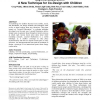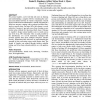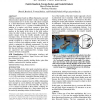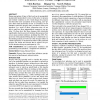CHI
2010
ACM
15 years 7 months ago
2010
ACM
As technology for children becomes more mobile, social, and distributed, our design methods and techniques must evolve to better explore these new directions. This paper reports o...
106
click to vote
CHI
2010
ACM
15 years 7 months ago
2010
ACM
Bicycling is an affordable, environmentally friendly alternative transportation mode to motorized travel. A common task performed by bikers is to find good routes in an area, whe...
CHI
2010
ACM
15 years 7 months ago
2010
ACM
We present Apatite, a new tool that aids users in learning and understanding a complex API by visualizing the common associations between its various components. Current object-or...
CHI
2010
ACM
15 years 7 months ago
2010
ACM
Tabletop computers based on diffuse illumination can track fiducial markers placed on the table’s surface. In this paper, we demonstrate how to do the same with objects arranged...
CHI
2010
ACM
15 years 7 months ago
2010
ACM
Blogging in the enterprise is increasingly popular and recent research has shown that there are numerous benefits for both individuals and the organization, e.g. developing reputa...
CHI
2010
ACM
15 years 7 months ago
2010
ACM
The use of whiteboards is pervasive across a wide range of work domains. But some of the qualities that make them successful—an intuitive interface, physical working space, and ...
CHI
2010
ACM
15 years 7 months ago
2010
ACM
As our technologies travel to new cultural contexts and our designs and methods engage new constituencies, both our design and analytical practices face significant challenges. We...
110
click to vote
CHI
2010
ACM
15 years 7 months ago
2010
ACM
Human perception of time is fluid, and can be manipulated in purposeful and productive ways. In this note, we propose and evaluate variations on two visual designs for progress ba...
CHI
2010
ACM
15 years 7 months ago
2010
ACM
A cord, although simple in form, has many interesting physical affordances that make it powerful as an input device. Not only can a length of cord be grasped in different location...
103
click to vote
CHI
2010
ACM
15 years 7 months ago
2010
ACM
Conversing on cell phones while driving an automobile is a common practice. We examine the interference of the cognitive load of conversational dialog with driving tasks, with the...




